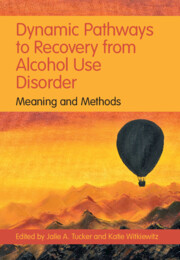Book contents
- Dynamic Pathways to Recovery from Alcohol Use Disorder
- Dynamic Pathways to Recovery from Alcohol Use Disorder
- Copyright page
- Dedication
- Contents
- Figures
- Tables
- Contributors
- Foreword
- Preface
- Acknowledgments
- Introduction
- Part I Micro Level
- 2 Biopsychosocial Process of Change in Alcohol Use Disorder Recovery
- 3 The Role of Self-Regulation Strategies in Recovery from Alcohol Use Disorder
- 4 Neuropsychological and Biological Influences on Drinking Behavior Change
- 5 Lifespan Developmental Perspectives on Natural Mechanisms of Cessation of Risky Alcohol Use and Recovery from Alcohol Use Disorder
- 6 Mutual Help Approaches and Mechanisms of Change
- 7 Time-Varying Effect Modeling to Examine Recovery Outcomes across Four Years
- 8 Latent Variable Mixture Modeling Approaches to Investigating Longitudinal Recovery Processes
- Part II Meso Level
- Part III Macro Level
- Conclusions and Future Directions
- Index
- References
8 - Latent Variable Mixture Modeling Approaches to Investigating Longitudinal Recovery Processes
from Part I - Micro Level
Published online by Cambridge University Press: 23 December 2021
- Dynamic Pathways to Recovery from Alcohol Use Disorder
- Dynamic Pathways to Recovery from Alcohol Use Disorder
- Copyright page
- Dedication
- Contents
- Figures
- Tables
- Contributors
- Foreword
- Preface
- Acknowledgments
- Introduction
- Part I Micro Level
- 2 Biopsychosocial Process of Change in Alcohol Use Disorder Recovery
- 3 The Role of Self-Regulation Strategies in Recovery from Alcohol Use Disorder
- 4 Neuropsychological and Biological Influences on Drinking Behavior Change
- 5 Lifespan Developmental Perspectives on Natural Mechanisms of Cessation of Risky Alcohol Use and Recovery from Alcohol Use Disorder
- 6 Mutual Help Approaches and Mechanisms of Change
- 7 Time-Varying Effect Modeling to Examine Recovery Outcomes across Four Years
- 8 Latent Variable Mixture Modeling Approaches to Investigating Longitudinal Recovery Processes
- Part II Meso Level
- Part III Macro Level
- Conclusions and Future Directions
- Index
- References
Summary
Alcohol researchers are often interested in identifying heterogeneous subgroups of drinkers, such as those with stable patterns of moderation drinking or patterns of heavy episodic drinking. Subgroups may also be identified based on qualitatively different developmental courses in the onset of alcohol use disorder (AUD) or pathways to recovery from AUD. This chapter provides an overview of latent variable mixture modeling, which can be useful for investigating such heterogeneity. First, mixture models applied to cross-sectional data are described, specifically latent class analysis and latent profile analysis. Then conventional latent growth modeling is discussed as a special case of growth mixture models, where subgroups of individuals are identified based on the shape of their growth trajectories. Mixture models applied to mediation analysis are also discussed. The chapter concludes with some practical issues to consider when using mixture modeling.
Keywords
- Type
- Chapter
- Information
- Dynamic Pathways to Recovery from Alcohol Use DisorderMeaning and Methods, pp. 137 - 156Publisher: Cambridge University PressPrint publication year: 2022



